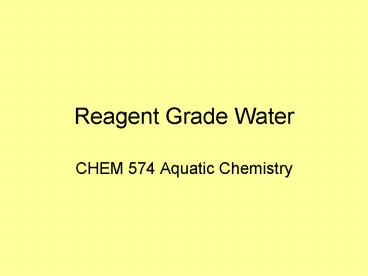Reagent Grade Water - PowerPoint PPT Presentation
1 / 14
Title:
Reagent Grade Water
Description:
Resistivity measures ionic substances only. Organics TOC, 10 ppb C = 1 mM C ... Deionizing cartridges. Carbon removal cartridge. Final filtration 0.2 mm pore size ... – PowerPoint PPT presentation
Number of Views:1937
Avg rating:5.0/5.0
Title: Reagent Grade Water
1
Reagent Grade Water
- CHEM 574 Aquatic Chemistry
2
Types of Contaminants
- Inorganic ions, ex. NaCl
- Organic compounds, ex. humics
- Colloidal material
- Bacteria
- Gases, ex. CO2
3
Water Quality Monitoring
- Resistivity measures ionic substances only
- Organics TOC, 10 ppb C 1 mM C
4
Laboratory Water Types
- Type III
- Type II
- Type I Reagent Grade, the best
5
Water Purification Techniques
- Ion Exchange
- Activated Carbon
- Microporous Filtration
- Ultrafiltration
- Reverse Osmosis
- Elix Continuous Deionization
- Ultraviolent (UV) Radiation
- Distillation
6
Ion Exchange
- Benefits
- Removes dissolved inorganics (ions) effectively.
- Relatively inexpensive.
- Limitations
- Does not effectively remove organics, particles,
pyrogens or bacteria. - Chemically regenerated DI beds can generate
organics and particles. - Single use resins require good pretreated water
quality so they dont become saturated.
7
Activated Carbon
- Benefits
- Removes dissolved organics and chlorine
effectively. - Long life due to high binding capacity.
- Limitations
- Does not efficiently remove ions and
particulates. - Can generate carbon fines.
8
Ultrafiltration
- Benefits
- Effectively removes most particles, pyrogens,
enzymes, microorganisms and colloids above their
rated size, retaining them above the ultrafilter
surface. - Limitations
- Will not remove dissolved inorganics or organic
substances. - May clog when challenged by an excessive level of
high-molecular-weight contaminants.
9
Reverse Osmosis
- Benefits
- Effectively removes all types of contaminants to
some extent (particles, pyrogens, microorganisms,
colloids and dissolved inorganics), and is
therefore useful as a first purification step. - Operation parameters (pressure, temperature, flow
rate, ionic rejection) are easy to monitor. - Limitations
- Cannot produce reagent grade.
- Membranes are vulnerable to damage.
10
Ultraviolent (UV) Radiation
- Benefits
- Effective sanitizing treatment.
- Oxidation of organic compounds to reach water TOC
levels below 5 ppb. - Limitations
- Photooxidation of organics is a polishing step,
able to decrease the TOC level only by a limited
value. - The CO2 produced during photooxidation decreases
the waters resistivity. - UV light will not affect ions, particles or
colloids.
11
Distillation
- Benefits
- Removes a broad range of contaminants and
therefore useful as a first purification step. - Can produce sterile water
- Limitations
- Many contaminants are carried to some extent into
the condensate. - Requires careful maintenance to ensure purity.
- Consumes large amounts of tap water (for cooling)
and electrical energy (for heating).
12
Net Result Need a Mixture
- Pretreatment of tap water deionization or
reverse osmosis - Two prefilters
- Activated charcoal
- Deionizing cartridges
- Carbon removal cartridge
- Final filtration 0.2 mm pore size
13
Now you have created
- Hungry Water!
14
Storage Dont!
- Glass contributes dissolved H4SiO4,and is an
active surface - HDPE DOC, many organics, acetic acid, memory
effects, (CH2)n polymer - Teflon no known solvent, inert, , (CF2)n
polymer - FEP a stronger type of Teflon, ,
crosslinked polymer

